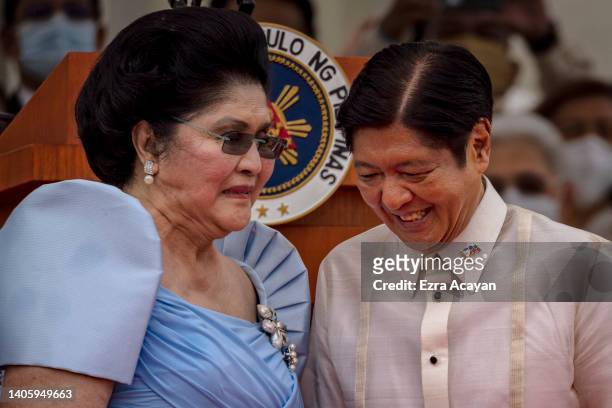Iron Butterfly
“The people need a role model…especially in the dark of night.”
–Imelda Marcos
Santo Niño Shrine and Heritage Museum (opened 1979)
Tacloban, Philippines
If a Grimm’s brother princess possessed the ability to write, her message would read, “A new pair of shoes can change your life-Cinderella.” A former First Lady of the Philippines would have wholeheartedly agreed. To partake of a dwelling of fairy tale proportions, enter the estate of the Santo Niño Shrine and Heritage Museum.
When thinking of historical figures associated with the Philippines, most do not visualize the island nation’s namesake, King Philip II of Spain. Most recall a presidential wife, alternately revered and reviled. The larger-than-life rags-to-(ill-gotten) riches tale began with Imelda Remedios Visitacion Romualdez, born in 1929 in Tacloban. Her father, Vincente, was a forty-three-year-old widower, whose reluctant bride was the twenty-seven-year-old Remedious. Their union added six more children to Vincente’s five from his deceased first wife. Miserable in her marriage, Remedious, along with her two sons and three daughters, moved into the garage. When Imelda was eight, her mother passed away from pneumonia. Upon losing his house to creditors, Vincente relocated from Manila to his hometown of Tacloban. Conditions further deteriorated with the Japanese invasion, and the thirteen-year-old Imelda, to the backdrop of planes raining death, sewed her clothes from the material of downed parachutes. The only currency Imelda possessed was her exquisite beauty. At age eighteen, she garnered the moniker The Rose of Tacloban in the Miss Philippines Contest.
Imelda’s destiny would have been as a Real Housewife of Manila had she not stepped into a congressional building in 1954 to avoid the heat and mosquitoes. Fernando Marcos noticed her in the Visitors’ Gallery and rushed over to meet the strikingly beautiful girl. He invited her out for ice cream, and over dessert declared his love. The smitten suitor sent Imelda a diamond for the next eleven days–until they became husband and wife. Referring to the daily delivery of diamonds, Imelda quipped, “I wish he could have courted me longer.” Their church ceremony was a society gala; the bride’s wedding band held eleven symbolic diamonds. The reception at the park opposite Malacañang Palace hosted 3,000 guests. One who did not receive an invitation was Fernando’s common-law-wife, Carmen Ortega, or their three children. With his legal spouse, Ferdinand fathered daughters Imee, Irene, and son, Fernando Jr., nicknamed Bongbong. Marriage did not stop Ferdinand from engaging in serial adultery.
Upon Marcos’ election as the country’s tenth president, crediting his wife’s campaign among the poor for his election, he praised her as his “secret weapon.” Life magazine pronounced Mrs. Marcos “the Jackie Kennedy of Asia.” Rather than serve as arm-candy to her husband, the First Lady’s pet project was erecting buildings dedicated to the arts. One of her architectural structures was a film center she touted would be “the Cannes of Asia,” designed to host events such as Miss Universe contests, and boxing matches between reigning champions Mohammad Ali and Joe Frazier.
As the daughter of a political dynasty and as the wife of president, Imelda served as the governor of greater Manila. Reveling in the position, Imelda met Presidents Nixon, Reagan, and Johnson, as well as Donald Trump, Prince Charles, Princess Margaret, Andy Warhol, Gloria Vanderbilt, Saddam Hussein, Fidel Castro, and Mao Zedong. She also became a Philippine Lady Macbeth who used her wifely wiles to influence her husband to substitute democracy for dictatorship in her quest for power and wealth. A Filipino anecdote related how President Marcos and General Fabian Ver met in Hell where the former General inquired, “Boss, I’ve committed treacherous acts but yours were way worse. So how come I’m covered in burning tar up to my neck, and you’re only covered up to your knees?” The deposed president replied, “I’m standing on Imelda’s shoulders.”
Over the next two decades, the President and his First Lady presided over a regime that tortured, incarcerated, and killed tens of thousands of “enemies of state.” They also amassed a ten-billion-dollar fortune that they hid in dozens of oversea accounts. A world-class shopper who would make the Kardashians appear miserly, Imelda embarked on multi-million-dollar shopping sprees in Manhattan, Rome, and Copenhagen. One real estate plum she turned down was the Empire State Building that came with a $750 million price tag as she felt it “too ostentatious.” Their art collection held Picassos, Michelangelos, and Botticellis; in the San Francisco airport, the First Lady bought $2,000 of gum. She purchased perfume by the gallon and once emptied duty-free shops across the globe of her favorite scent so no one else would carry her signature scent.
Amidst the laissez spending and palatial residences, horror intruded. In 1972–the same year the president imposed martial law–while the First Lady presided over a televised award ceremony, Carlito Dimahilig stabbed her eleven times with a twelve-inch bolo knife. A security guard shot the assassin twice in the back. Imelda received seventy-five stiches and commented, “If somebody’s going to kill me-why such an ugly instrument?” She took to wearing bulletproof bras. President Nixon called with his condolences. 
With the economy in shambles due to the First couple using the Philippines as their personal piggy bank, protests erupted from students, opposition leaders, and the poverty-stricken populace. Nevertheless, just as Nero fiddled while Rome burned, Imelda boogeyed in Manhattan’s Studio 54. A megalomaniac till the end, Ferdinand clung to power. However, fearful of the mob demanding their heads Ferdinand, Imelda, and their children escaped in a helicopter. Imelda described their flight, “The slipper was lost. And everything turned into a pumpkin.” When the protestors stormed the Philippine Versailles, they found a treasure trove of art masterpieces, a multi-million-dollar collection of jewelry, and uneaten caviar on a dining room table. The reported 3,000 shoes in Imelda’s closet captivated the world’s attention; in reality, there were 1,060 including one battery-equipped pair that glowed in the dark. Of the brouhaha, Imelda remarked, “They went into my closets looking for skeletons, but thank God all they found were shoes, beautiful shoes.” The media dubbed her “Marie Antoinette with shoes.” The woman who had graced magazine covers now faced mugshots. Billionaire gal pal Doris Duke bailed her out for five million dollars.
Three years later, Ferdinand died in exile, and his widow was distraught when the Philippine government refused to allow burial in his homeland. The future president, Rodrigo Duterte, relented, and Imelda arranged for her husband’s reburial in the Heroes’ Cemetery in Manila. His tombstone read: “Filipino” beneath his name and the years of his birth and death. The yo-yo, invented in the Philippines, is an apt metaphor for Imelda who refused to stay down. The former First Lady became a congresswoman for her hometown province of Leyte. Imee, who told her people “to move on” from the past, served as the governor for the province of Ilocos Norte. Perhaps due to historic amnesia, in 2022, Bongbong became the seventeenth Philippine president.
Imelda Marcos told biographer Katherine Ellison, “All I ever dreamed of when I was a tiny girl was a little house with a little picket fence by the sea.” As an adult, Imelda had twenty-nine pleasure domes. One was a grandiose red mansion with dozens of white arches set amidst a huge plot of land. The 21, 500 square foot seaside residence was a present from Marcos to his wife, built in her hometown, dedicated to its local saint. A chapel dominates the ground floor with an image of Santo Niño. Hallways display paintings of the Stations of the Cross, as well as a gargantuan mosaic of Jesus. Rather than a domicile, (Imelda is alleged to have only stayed at her home for one night), the estate is also a shrine to Imelda. The Presidential Commission on Good Government turned her residence into a museum where visitors marvel at the Olympic-sized backyard swimming pool, enormous state dining rooms, and ballroom, a replica of the one in Malacañang Palace. In the center of the grand room is a shell-encrusted fountain. All twenty-one bedrooms represent various Filipino regions with the commonality every one displays a signed photograph of the president and his wife along with a diorama of Imelda. The largest suite belonged to Imelda that has more square footage than the average Filipino home. A floor to ceiling painting shows the lady of the manor rising from the sea holding a giant shell with miniature portraits of the Marcos family.
The mansion juxtaposes ecclesiastic paintings from Italy, France, and Germany along with secular treasures that include Ming dynasty vases, grand pianos, and ivory sculptures. An international treasure chest displays Czech Republic chandeliers, Argentine carpets, Chinese porcelain vases, Italian tiles, and Austrian mirrors. Departing the shrine, visitors are left wondering at the magic wand that transformed a Cinderella into the Iron Butterfly.
The View from Her Window: Peering over her heritage house-museum, Imelda might have envisioned an alternate road, one where she would have worshipped Sañto Nino over mammon.


